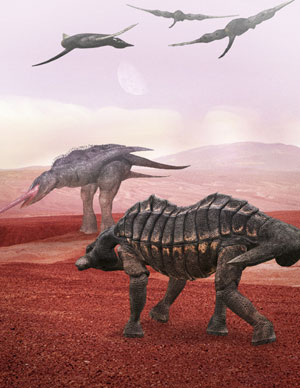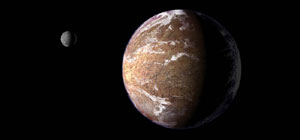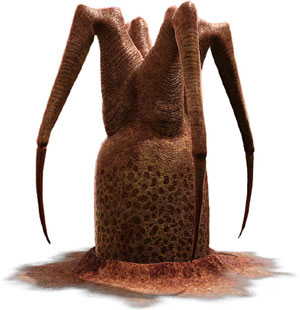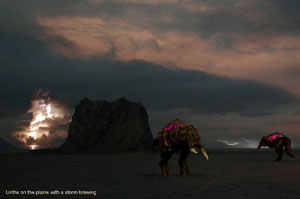ALIEN PLANET TAKES A VIRTUAL MISSION IN SEARCH OF INTELLIGENT LIFE IN NEW DISCOVERY CHANNEL WORLD PREMIERE, SATURDAY, MAY 14, AT 8 PM (ET/PT)
By The Editor
May 12, 2005 - 08:27
 |
| Alien Planet |
ALIEN PLANET takes viewers on a dramatic virtual mission of the future – a trip to a fictional planet known as Darwin 4 — in a new Discovery Channel world premiere Saturday, May 14, 8-10 PM (ET/PT). Rooted in the latest scientific research from the NASA Origins Program, NASA/Jet Propulsion Laboratory (JPL) Planet-Finder Mission and European Space Agency’s Darwin Project, this special two-hour computer-animated program features some of the world’s most renowned scientists, including Stephen W. Hawking, Michio Kaku and J. Craig Venter, plus Star Wars filmmaker George Lucas, who discuss the possibilities of life outside our solar system and deconstruct the animals on Darwin 4, based on the laws of evolution and physics. The premiere of ALIEN PLANET kicks off Discovery Channel’s “Space Week,” May 14-21. “The life we have on Earth must have spontaneously generated itself,” says Stephen W. Hawking, physicist and author of A Brief History of Time. “It must therefore be possible for life to be generated spontaneously, elsewhere in the universe.”
And, as the story unfolds, that would be Darwin 4, located 6.5 light years from Earth, with two suns and 60 percent of Earth’s gravity. Having identified Darwin 4 as an environment that could support life, Earth sends an unmanned pilot mission consisting of a “mother ship,” dubbed Von Braun, and three probes: Balboa, da Vinci and Newton. Their goal: find and assess any life forms on Darwin 4.
 |
| Approaching Darwin 4 |
Initially, the expectation is to find microscopic life, but the probes soon find themselves in the middle of a developed ecosystem teeming with diversity of life of all sizes – just like Earth. “If you look at the diversity of what species look like on this planet, nature has come up with better things than our best science fiction,” comments J. Craig Venter, of the J. Craig Venter Institute, who successfully mapped the human genome.
 |
| Butcher's tree |
Visually based on author/artist Wayne Barlowe’s book Expedition, and rooted in real-life exploratory endeavors scientists have designed the planet of Darwin 4 (which lies in a known star system), the probes and the spacecraft, as well as the various life forms found there. The mission is brought to vivid life via state-of-the-art computer animation and visual effects by Meteor Studios, the creative team behind the Emmy Award-nominated When Dinosaurs Roamed America.
Among the scientists and others who comment on the mission to Darwin 4 are Hawking; Venter; Kaku; Jack Horner, paleontologist, Montana State University; and Star Wars filmmaker George Lucas. The scientists and evolutionary biologists who developed the mission and its possible results include Garvin; Victoria Meadows, research scientist, NASA/JPL Virtual Planet Laboratory; Randy Pollock, space instrumentation system architect, Hamilton Sundstrand; Joan
Horvath, executive director, Global Space League; James Kirkland, state paleontologist, Utah Geological Survey; David Moriarty, professor, Biological Sciences Department, California State Polytechnic University; and Curtis Clark, professor, Biological Sciences Department, California State Polytechnic University.
 |
| Storm approaching the sunths |
